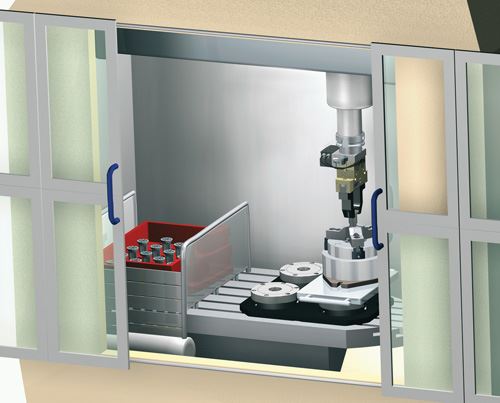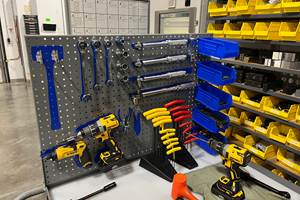Automation On Demand
A workpiece gripper that installs in a machine tool's spindle enables the machine to serve as its own robot.
Share




The variety of work that flows through contract shops makes it difficult for those businesses to justify automation for their milling machines. Manual machine loading is generally the best option, especially when batch sizes are very small. That said, a machine-tending robot may be appropriate for repeating, long-run jobs. However, if that work is sporadic, a shop may find that dedicating a robot to a machine tool is neither practical nor affordable.
Schunk (Morrisville, North Carolina) has developed a workpiece gripper that enables a machine tool to serve as its own robot. The gripper has an integral taper that installs in a machine’s spindle just like a tool holder. This allows the machine to pick parts from a magazine on its work table and insert them into a workholding device for machining. Once a new part is loaded, the machine’s ATC swaps the gripper for a cutting tool, storing the gripper in the ATC magazine. Such inexpensive, on-demand automation allows shops to perform manual loading when batches are small and use the gripper to automate longer runs, perhaps overnight or during the weekend.
An internal spring holds the gripper’s fingers open until it is overcome by the pressure of through-spindle coolant or compressed air. A bypass valve reduces the high pressure of the through-spindle coolant to an appropriate level required to actuate the gripper. Excess coolant flows out of a valve on the side of the gripper as it holds a part. (Other models actuate the fingers in the opposite manner, using the internal spring to provide the gripping force and coolant pressure to expand the fingers.)
The grippers are available in most common spindle interfaces, including CAT, HSK, KM and Capto. Two-finger versions are offered in nominal gripper widths of 50, 64 and 80 mm for ID or OD gripping. Three-finger models are also available. Depending on the gripper’s size, adjacent ATC pockets may have to remain open to accommodate the device.
Schunk uses the gripper in-house for unattended machining of tool holders on an Okuma MC-V4020 VMC. A Lyndex-Nikken manual indexer installed on the machine’s bed serves as the workpiece storage magazine. The gripper removes a new part from the magazine and installs it in a clamp on a rotary table. The ATC then changes out the gripper for the requisite cutting tool. After machining is completed, the gripper returns to the spindle, removes the finished part from the clamp and delivers it to the manual indexer. It remains in contact with the completed part so that it can rotate the indexer to bring the next part to be machined to the twelve-o’clock position.
The three nominal gripper widths noted above offer maximum finger lengths of 64, 80 and 100 mm, respectively. The largest gripper version can hold parts as heavy as 3.9 kg. Schunk also offers a wireless sensor system to relay finger position. Sensors inside the gripper monitor the stroke of gripper jaws, while a transmitter sends sensor signals to a receiver that is wired to the machine control.
Related Content
Inside the Premium Machine Shop Making Fasteners
AMPG can’t help but take risks — its management doesn’t know how to run machines. But these risks have enabled it to become a runaway success in its market.
Read MoreLean Approach to Automated Machine Tending Delivers Quicker Paths to Success
Almost any shop can automate at least some of its production, even in low-volume, high-mix applications. The key to getting started is finding the simplest solutions that fit your requirements. It helps to work with an automation partner that understands your needs.
Read MoreWhich Approach to Automation Fits Your CNC Machine Tool?
Choosing the right automation to pair with a CNC machine tool cell means weighing various factors, as this fabrication business has learned well.
Read MoreTranslating a Prototyping Mindset to Production
The experimental mindset that benefited BDE Manufacturing Technologies as a prototype job shop has given it an adaptable edge as a production facility.
Read MoreRead Next
Video: Parts Gripper Allows Machine To Act As Its Own Robot
This footage shows a workpiece gripper that enables a machine to load and unload workpieces on its own.
Read More5 Rules of Thumb for Buying CNC Machine Tools
Use these tips to carefully plan your machine tool purchases and to avoid regretting your decision later.
Read MoreRegistration Now Open for the Precision Machining Technology Show (PMTS) 2025
The precision machining industry’s premier event returns to Cleveland, OH, April 1-3.
Read More


















.jpg;maxWidth=300;quality=90)


.jpg;maxWidth=300;quality=90)















